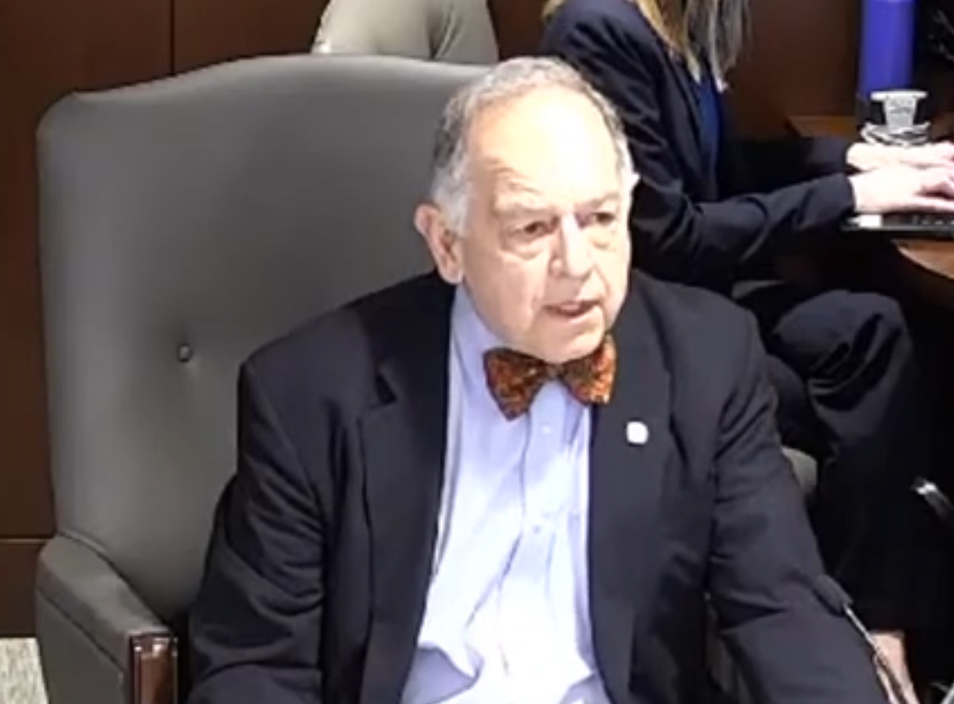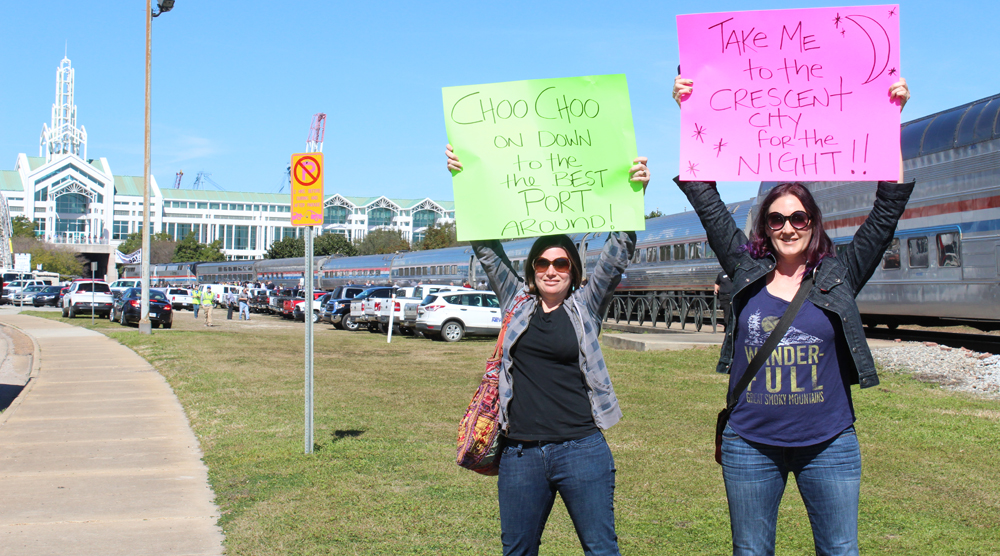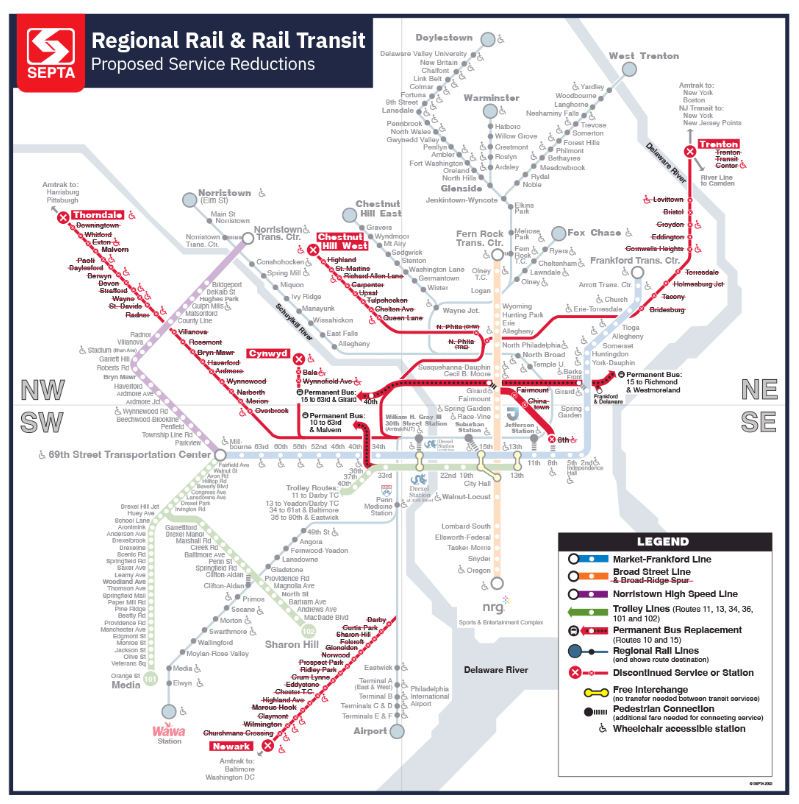
WASHINGTON — Host railroads and Amtrak have not presented enough information to allow the Surface Transportation Board to determine whether two daily passenger round trips between New Orleans and Mobile, Ala., would “unreasonably” impair freight operations, board chairman Martin Oberman said Thursday.
Oberman made the statement as part of a wide-ranging commentary at the conclusion of Thursday’s session, the 11th day of testimony spanning more than a month in the hearing involving Amtrak, CSX, Norfolk Southern, and the Port of Mobile.
Stressing that no rulings had been made thus far, Oberman gave the parties more than 30 days to address a series of “observations and suggestions” when the next session takes place on Monday, June 13. He outlined a series of disconnects between the underlying assumptions offered by the freight carriers and Amtrak, compared with what the applicable statute and public interest demanded.
The railroads have interpreted “unreasonable” impairment as “no” impairment to operations. “Presumably Congress anticipated some impairment when they wrote that language,” says Oberman, adding, “The [Rail Traffic Controller] modeling doesn’t meet the standards of the statute.” The freight railroads are relying on that traffic modeling in seeking extensive infrastructure upgrades before Amtrak is allowed to operate.
Among his specific criticisms:
— The impact of possible operational changes was not considered in the RTC study.
— A goal of 95% on-time performance was set for Amtrak trains (though the modelers attempted to walk back that assumption during the proceedings). This is a significantly higher standard that that set by the Federal Railroad Administration.
— Field data on traffic collected via interviews had no back-up documentation.
— No evidence was presented to establish a cost benefit of individual capital projects.
— No customer-centric data on the impact to individual shippers has been offered.
“The evidence we heard is that these infrastructure products are needed to have certain reductions in freight delay 20 years from now,” Oberman said. “I don’t see that in the statute. That strikes me as a little too long to commit public resources at this stage.”
He also said the railroads gave no guidance as to how to measure “reasonableness” because they provided no comparisons to the velocity of their overall network, which the chairman has criticized in other STB proceedings. “Is this like pornography: we know it when we see it?” Oberman asked rhetorically.
The railroads never modeled the FRA’s infrastructure recommendations on 2019 operating data, only on 2039 projections. The FRA has suggested improvements totaling $99 million are needed.
“It’s absence causes me [to be] inclined to draw a negative inference .. .but I would rather see the numbers,” Oberman said. “I find that a big gap in the evidence that has been submitted to us.”

Amtrak had supported the FRA finding, derived from the Gulf Coast Working group report of 2017, but Oberman said he didn’t see any evidence presented by Amtrak that starting service before improvements are made — which it seeks to do — wouldn’t cause unreasonable impairment. “Will it take a year, will it take two years, will it take six months to build whatever infrastructure Amtrak says it supports?” he asked. “I find that to be a huge gap in the evidence which makes it difficult for us — for me, anyway — to reach a decision.”
A request to ‘fill in the gaps’
Oberman concluded, “I am going to recommend that we invite the parties to fill in these gaps in the evidence. I’m doing this in part because when this case is over and we do issue an order, I want it to not only decide this case, but because of the importance everybody has said about this being precedent-setting, to set some goals, milestones, and rules as to how these cases are to be litigated.”
He also noted that although railroads have the burden of proof, Amtrak can’t necessarily prevail by offering no contradictory evidence.
“I’ve expressed my concerns about the status of those RTC reports,” he said. “There is a huge public interest here in restoring passenger service to the Gulf Coast — Congress has said so. I also don’t think it serves the public interest to say the railroads have failed their burden of proof, so start running four trains without infrastructure. There’s been enough testimony to suggest that would cause some disruption. You can’t tell whether it’s unreasonable. So, to protect the public interest, we need to nail this down better.”
Oberman suggested that during the proposed 30-day hiatus that the railroads rerun the model to further incorporate Port of Mobile operations, and Amtrak use the RTC software with operational changes or far less infrastructure than the railroads are asking for. He was referring, however, to the study by consultant HNTB, which contains assumptions of randomized activity and train starts based on interviews, which Amtrak has contested. Inputs of the never-completed 2020 HDR study, also derived from 2019 data, were finally made available to Amtrak in September 2021 before the HNTB modeling was completed.
“Once you have submitted the additional evidence, I think it is essential that we reconvene and give the parties a chance to present that evidence and be cross-examined on it,” Oberman said. “It’s up to you. If you say the case is over then we will schedule the closing arguments.”
He noted that one witness said that parties involved in RTC studies normally get into a room and try different options. “That clearly did not happen here. It would be constructive if you present more evidence to do it that way, he said. “I can’t make you play nice,” said Oberman.
Board member Karen Hedlund followed his views with the observation that there was “a profound lack of cooperation,” and member Robert Primus asserted, “There are still some truths we need to know.”
In a recording of Thursday’s session, Oberman’s observations begin at the 2:45:30 mark. It and all other sessions of the hearing to date are available at the STB’s YouTube channel.














Don – I wouldn’t say “nowhere”; UP says their average speed is 25MPH. However, I did checked a couple of different non-railroad specific sources, and 22-23 MPH was given as the overall average freight train speed for the US. I believe we can agree the rails need to speed up freight service, if not for Amtrak, to be competitive.
Jeffery – nowhere in the US is the average merchandise train speed 25 mph.
In 1955, the average length and speed of a freight train was approximately 2700 feet and 18.5 MPH. In 2022, it’s 7500 feet and 25 MPH. A “no improvements” solution – give freight trains rights over Amtrak trains regardless of direction, time of day, and frequency, i.e., Amtrak train(s) always take the siding and hold until the freight train(s) pass. Any advocates for that solution?
Freight trains today are more like 12,000 to 15,000 feet long. I know, I’ve worked on them. A mainline will barely hold them. Passenger trains were known for their speed in the early days, even the 1950s.
A few thoughts:
This has been the first time Amtrak has really fought back against the host roads – especially publicly.
A different base case needs to be explored. The “what if Katrina never happened” case. The Starlight continues to run. The RRs go to their monster DPU strategy. What capital improvements do they make to support the operational change? My hunch is none. They just muddle through as best they can. They certainly wouldn’t have made all the investments to keep status-quo level of service. Just look at the rest of their networks.
A third case need to be looked at as well. What was the performance of the RR just before Katrina? What is the trade off in cost of operation vs. capital investment to support DPU trains at the same service level. Certainly, a return to non-DPU trains would reduce impairment – at some operations cost.
I feel like Marty Oberman is reading my mind. Nails it.
If it is precedent setting, then lets get the facts and evidence in order so we can use it as the model going forward.
I watched the Chairman’s closing comments on the 12th. In addition to what Bob has noted in his story above, Chairman Oberman also made it crystal clear to both sides they were rolling the dice (so to speak) and would be far better off to come back on June 13 with an agreement they had worked out between themselves.
“Just because tracks exist does not mean they should carry a passenger train as once done” strikes me as an understatement in this case. In 1955, the L&N railroad had 12 regularly scheduled passenger trains running every day in each direction. This was infrastructure 67 years ago and those trains RAN at speeds higher than what is scheduled for these two Amtrak trains. Mix and match all the numbers you choose to reach whatever conclusion you desire. There is no way you can explain the abilities of the railroad through here 67 years ago versus todays infrastructure. That’s laughable. The people want and need this service, regardless if it extends on to Baton Rouge or makes millions toward Amtrak’s bottom line. This route was fine to run the Sunset until hurricane Katrina washed the tracks away…temporarily! Research how quickly CSX rebuilt this entire line. I call all this corporate greed BULLSHIT! Run the damn train!
Very true,
It seems to me that Mr Oberman’s actions are keeping with the Fifth Amendment in respecting the rights of the private property owners (the railroads and their stockholders). No need to rush things.
I see Mr. Oberman is unwilling to take the bull by the horns and just go with what was presented. I would posit that a favorable ruling in Amtrak’s favor would force the RR’s hands since this is supposed to be a precedent setting decision. In plain American English for the rest of you, they refused to play ball and provide information because of “confidentiality and proprietary” BS, since that’s the case, then in my book the railroads, the Port of Mobile, et al have no grounds to stand on and must allow the service to start ASAP, no if’s and’s or buts about it.
Yes!
I am thankful that the STB has Mr. Oberman in the role of Solomon. He is calling both sides to task for the disinformation they offering as justification for what they don’t want to do or do. I hope he can get them to cooperate but railroads are known for stubbornness.
As the Cable guy says…”Get er done”
Talk about “gaps,” where are the facts re:
1) Will the proposed Amtrak schedules be timed to connect arrival and departure of the long distance trains serving New Orleans, e.g., “City of New Orleans,” “The Crescent,” and “Sunset Limited”? If not, how does Amtrak imagine building the necessary base for traffic?
2) Will the Gulf Coast trains be a continuation of the proposed Baton Rouge trains to run thru New Orleans to increase asset utilization and extend market potential?
Given the cost reality of such a short haul route requiring far more travel time than the bus; unproven assumptions of ridership, what if Amtrak emulated American Airlines and utilized a dedicated bus on this proposed route? Such a bus concept has worked well for Amtrak in California to successfully expand the market of the state’s 3 regional trains at a far lower cost. Such an operation would allow increased frequencies to enable the market to grow, while directly feeding the long distance schedules and Baton Rouge.
As the days of a fully crewed mixed train, as well as an RDC, are over; just because tracks exist does not mean they should carry a passenger train as once done.
Indeed, how Amtrak assesses costs, should this measurement apply to the unfinished Chicago-Moline (IL) and Chicago-Rockford (IL) routes?
Reflecting upon the inability of Amtrak’s leadership to understand and define cost controls beyond dismissing experienced employees, the STB should help Amtrak to identify the correct allocation of costs to evidence an accurate model to support its argument re the feasibility of this short haul market. If not, the dedicated bus would suffice operating on a more frequent, lower cost schedule.
M.E. Singer…the PEOPLE want the service, that is all you need to know, Amtrak us supposed to serve the PEOPLE. The Amtrak California buses are extensions of existing Amtrak rail service and most people don’t use the bus just for the route but to actually reach the Amtrak train and board that. Big difference when you’re talking about a train from Mobile to New Orleans that people want and would ride, as they locals have vocally displayed numerous times already.
Exactly Mr. McFarlane, Thank you sir.